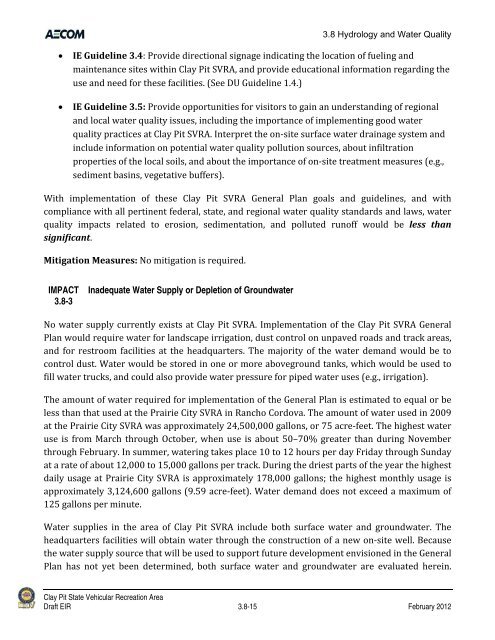Draft Environmental Impact Report - California Off Highway Vehicle ...
Draft Environmental Impact Report - California Off Highway Vehicle ...
Draft Environmental Impact Report - California Off Highway Vehicle ...
Create successful ePaper yourself
Turn your PDF publications into a flip-book with our unique Google optimized e-Paper software.
3.8 Hydrology and Water Quality<br />
IE Guideline 3.4: Provide directional signage indicating the location of fueling and<br />
maintenance sites within Clay Pit SVRA, and provide educational information regarding the<br />
use and need for these facilities. (See DU Guideline 1.4.)<br />
IE Guideline 3.5: Provide opportunities for visitors to gain an understanding of regional<br />
and local water quality issues, including the importance of implementing good water<br />
quality practices at Clay Pit SVRA. Interpret the on‐site surface water drainage system and<br />
include information on potential water quality pollution sources, about infiltration<br />
properties of the local soils, and about the importance of on‐site treatment measures (e.g.,<br />
sediment basins, vegetative buffers).<br />
With implementation of these Clay Pit SVRA General Plan goals and guidelines, and with<br />
compliance with all pertinent federal, state, and regional water quality standards and laws, water<br />
quality impacts related to erosion, sedimentation, and polluted runoff would be less than<br />
significant.<br />
Mitigation Measures: No mitigation is required.<br />
IMPACT<br />
3.8-3<br />
Inadequate Water Supply or Depletion of Groundwater<br />
No water supply currently exists at Clay Pit SVRA. Implementation of the Clay Pit SVRA General<br />
Plan would require water for landscape irrigation, dust control on unpaved roads and track areas,<br />
and for restroom facilities at the headquarters. The majority of the water demand would be to<br />
control dust. Water would be stored in one or more aboveground tanks, which would be used to<br />
fill water trucks, and could also provide water pressure for piped water uses (e.g., irrigation).<br />
The amount of water required for implementation of the General Plan is estimated to equal or be<br />
less than that used at the Prairie City SVRA in Rancho Cordova. The amount of water used in 2009<br />
at the Prairie City SVRA was approximately 24,500,000 gallons, or 75 acre‐feet. The highest water<br />
use is from March through October, when use is about 50–70% greater than during November<br />
through February. In summer, watering takes place 10 to 12 hours per day Friday through Sunday<br />
at a rate of about 12,000 to 15,000 gallons per track. During the driest parts of the year the highest<br />
daily usage at Prairie City SVRA is approximately 178,000 gallons; the highest monthly usage is<br />
approximately 3,124,600 gallons (9.59 acre‐feet). Water demand does not exceed a maximum of<br />
125 gallons per minute.<br />
Water supplies in the area of Clay Pit SVRA include both surface water and groundwater. The<br />
headquarters facilities will obtain water through the construction of a new on‐site well. Because<br />
the water supply source that will be used to support future development envisioned in the General<br />
Plan has not yet been determined, both surface water and groundwater are evaluated herein.<br />
Clay Pit State Vehicular Recreation Area<br />
<strong>Draft</strong> EIR 3.8-15 February 2012








